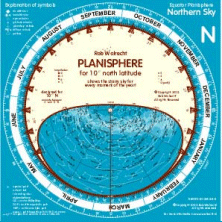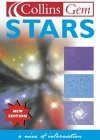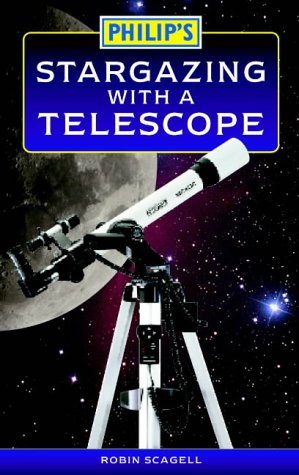 |
|
| [getting started in astronomy] · [my equipment] · [gallery] · [links] · [home] | |
| Getting Started in astronomy | |
| CONTENTS
Getting to know your fellow observers To be added later: Buying a star-chart |
|
| Learning the constellations Your first step into observational astronomy is to learn the most prominent stars and constellations. This is a bit like getting to know your way around in a new town. Among the first things you become familiar with, are the remarkable features, like tall buildings, main-roads, squares, rivers, canals and bridges. Later on you use their positions in order to locate smaller items. Now maybe you've run accross advertisements for starter-scopes with a go-to facility. These advertisements claim that the telescope does all the searching for you. For some (not all!) go-to telescopes this is true indeed, but they come with a price-tag. If you want to do astronomy inexpensively, then go-to is not your thing right now.
The easiest way to learn the constellations and their brightest stars, is by means of a planisphere, like the one shown above. A planisphere is an all-sky map with an overlay which can rotate relative to the map. By rotating the overlay (or the map) you can select your current date and time. The map now shows what the sky looks like at that particular moment. Now go out on a clear night, with your planisphere and a flashlight (preferrably a not too bright one) and try which constellations you can distinghuish. If you think this is fun, you might enjoy astronomy. If not, sell your planisphere on e-bay, or wrap it as a birthday gift. Planispheres come in many shapes and sizes. Most serious bookstores are likely to sell them, but you can also order one at an on-line bookstore. The most important thing to consider if you buy one, is that it matches the geographical latitude of your location. Personally I prefer the square planispheres by the Dutch author Rob Walrecht, which contain a lot of additional information. The round ones are simpler, yet cheaper, and available in English and German too.You can order Rob Walrecht's planispheres directly from the author, see my links-page or click here. If you want to read some background information on the constellations you are observing, I recommend the book 'Stars' by Ian Ridpath and Wil Tirion. (Paperback 192 pages, January 2000 Publisher: Collins, ISBN: 0004724747)
This brilliant little book has one or two pages of descriptive text dedicated to each of the 88 constellations, with a map of the constellation on the facing page. In its introduction it also provides a concise overview of astronomy.
Getting to know your fellow observers While you're on your way exploring the night sky, it might be a good idea to check out an astronomy club or public observatory in your neighbourhood. These places are usually full of enthousiasts who are more than willing to help you. Many times these places also offer you the opportunity to watch through a telescope. If you have trouble finding such a club or observatory, then check out the local phone directory or buy an issue of a local or national astronomy magazine.
"No, your first instrument is not a telescope . . . Buy a pair of binoculars." That's what everybody told me, but I stubbornly ignored it. I converted my 400mm telephoto lens to a simple telescope by adding an eyepiece and a finder to it. It worked ok, but I wasn't getting any further than observing the moon, because that was about the only object I was able to find. After a while I gave up my resistance and I bought binoculars and I fixed them to a photo-tripod. It made all the difference! Now I was able to find many objects which had stayed elusive until that moment. I will never forget the evening on which I first saw M 31, the famous galaxy in Andromeda. Although only the brightest part of the core of the galaxy is visible through simple instruments, it nevertheless was a thrill to watch such a distant object. Binoculars are a good investment. Although I own four fairly decent telescopes, I still use my binoculars a lot, especially when I am searching for objects which I haven't observed before. Even if you come to the conclusion that astronomy is nothing for you, your binoculars are still usefull for watching other phenomena and events.
Now what kind of binoculars should you buy? Most binoculars are suited for astronomy, but not all! In order to help you, I set up a few guidelines. 1. Buy the right type Binoculars are characterised by a set of numbers, like 10 X 25, 7 X 50 etc. The first number is the magnification, and the second is the aperture in millimeters of the objective lenses. Dividing the second number by the first, yields a figure of merit for the light-gathering power of the instrument. As a rule of thumb, this figure should not be below 4. So an 8 X 40 is fine, but a 7 X 25 will give images which are too dim to be usefull for astronomical purposes. A 7 X 50 is brilliant. Big instruments like 12 X 80 's are great for experienced observers, but it's not a good idea to start with such an instrument. Keep magnification (the first of the numbers) between 6 and 10. Avoid zoom-binoculars. The good ones are quite expensive, and the affordable ones are easily outclassed by a non-zoom instrument at a similar price. 2. Try before you buy There are a lot of different factors which determine whether you can see comfortably through a pair of binoculars or not. Find a shop where you can try binoculars before you buy them. A helpful and competent salesperson can be of great use here. Find out, for instance, whether the weight and size of the instrument are ok for you. Although I was out for a 7 X 50, it appeared while trying, that I could hold a lighter 8 X 40 much steadier. Of particular importance is the distance between your eyes and the back-lenses of the eyepieces. When you wear glasses, for instance, it's important that you can leave them on while viewing through your instrument. It's also important that you check whether the distance between your both eyes matches the adjustment range of the binoculars. I was born in Groningen, and like me, many people from Groningen have big heads! You may laugh now, but most hats or caps won't fit! Neither do some Japanese bino's, which do not have the facility to place both halves of the binoculars far enough apart to match the distance between my eyes! Also pay some attention to the stability of the focussing mechanism. While watching the stars, on many occasions you use your binoculars almost vertically, with the back of the instrument resting against your eyebrows. That way, a lot more strain is exerted on the focusing mechanism than is during horizontal operation. A good general test is to point the instrument at an object at a distance of at least 50 m. Focus the instrument. Does it make a difference to what you see if you cover either of the objective lenses with your hand? If not, then one of your eyes is not looking through the instrument! Correct the eye-distance and try again. It's not unlikely that you will find instruments for which it will never work! Don't worry, differences can be very individual, but that is exactly why it is so important that you try before you buy! 3. Keep it simple Some bino's are packed with bells and whistles, most of which are hardly of any use for astronomy. A pair of binoculars which shows a compass dial or which remains afloat if it falls into the water may be great when you own a boat, but it's not really a must-have for astronomy. Roof-top prisms are great, but porro prisms are sufficient. There are some 'gags', however, which are not necessary, but can be very usefull, like multi-coating on all optical surfaces, and the provision for attaching the instrument to a tripod. Finally, when you expect to spend between 70 and 100 Euro's / Dollars, you should be able to buy a pair of decent binoculars, well suited for astronomy. Now do I hear the rich kids in the back of the audience murmur that bino's by Fujinon or Zeiss are better than the Chinese-made binoculars I recommend? Of course that is true, but that doesn't render less expensive bino's useless, and remember this is INEXPENSIVE ASTRONOMY.
Don't buy a telescope before you know what you want to see with it. Some people, like my father, like to watch brights comets and other phenomena which appear from time to time. He reads the announcements in the astronomy column of the newspaper, and has a superficial, yet sufficient knowledge of the night sky, which enables him to find and enjoy special celestial events. He is a typical casual observer, and he is perfectly content with his 10 x 50 binoculars, which he bought 30 years ago. Are you an observer like my dad? Then a telescope is a waste of money! On the other hand, if you followed the steps above, and you can't wait to see the Great Red Spot on Jupiter, Saturn's rings or admire the breathtaking beauty of M42, which you read so much about? Then start saving money and acquire the necessary knowledge to buy a telescope. Buying the right telescope first shot is difficult. In my case the book 'Stargazing with a telescope' by Robin Scagell helped a lot. (Paperback 160 pages, 2000 Publisher: George Philip Limited, ISBN: 0540077135)
It explained all the necessary details. (to be continued)
|
|


